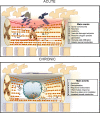Tamoxifen: an FDA approved drug with neuroprotective effects for spinal cord injury recovery
- PMID: 27651756
- PMCID: PMC5020807
- DOI: 10.4103/1673-5374.189164
Tamoxifen: an FDA approved drug with neuroprotective effects for spinal cord injury recovery
Abstract
Spinal cord injury (SCI) is a condition without a cure, affecting sensory and/or motor functions. The physical trauma to the spinal cord initiates a cascade of molecular and cellular events that generates a non-permissive environment for cell survival and axonal regeneration. Among these complex set of events are damage of the blood-brain barrier, edema formation, inflammation, oxidative stress, demyelination, reactive gliosis and apoptosis. The multiple events activated after SCI require a multi-active drug that could target most of these events and produce a permissive environment for cell survival, regeneration, vascular reorganization and synaptic formation. Tamoxifen, a selective estrogen receptor modulator, is an FDA approved drug with several neuroprotective properties that should be considered for the treatment of this devastating condition. Various investigators using different animal models and injury parameters have demonstrated the beneficial effects of this drug to improve functional locomotor recovery after SCI. Results suggest that the mechanism of action of Tamoxifen administration is to modulate anti-oxidant, anti-inflammatory and anti-gliotic responses. A gap of knowledge exists regarding the sex differences in response to Tamoxifen and the therapeutic window available to administer this treatment. In addition, the effects of Tamoxifen in axonal outgrowth or synapse formation needs to be investigated. This review will address some of the mechanisms activated by Tamoxifen after SCI and the results recently published by investigators in the field.
Keywords: anti-inflammatory; antioxidant; demyelination; estradiol; reactive gliosis; regeneration; selective estrogen receptor modulator; trauma.
Conflict of interest statement
Conflicts of Interest: None declared.
Figures


References
-
- Bydon M, Lin J, Macki M, Gokaslan ZL, Bydon A. The current role of steroids in acute spinal cord injury. World Neurosurg. 2013;82:1–7. - PubMed
-
- De la Torre Valdovinos B, Dueñas Jiménez JM, Jimenez Estada I, Banuelos Pineda J, Franco Rodríguez NE, Lopez Ruiz J, Osuna Carrasco L, Candanedo Arellano A, Dueñas Jiménez SH. Tamoxifen promotes axonal preservation and gait locomotion recovery after spinal cord injury in cats. J Vet Med. 2016:1–16. - PMC - PubMed
-
- Hauben E, Mizrahi T, Agranov E, Schwartz M. Sexual dimorphism in the spontaneous recovery from spinal cord injury: a gender gap in beneficial autoimmunity? Eur J Neurosci. 2002;16:1731–1740. - PubMed
Publication types
Grants and funding
LinkOut - more resources
Full Text Sources
Other Literature Sources
Miscellaneous

